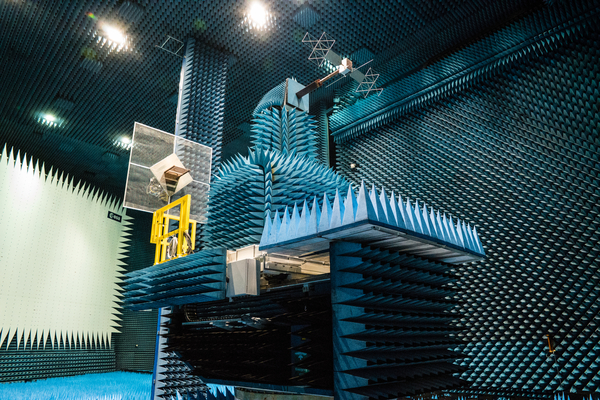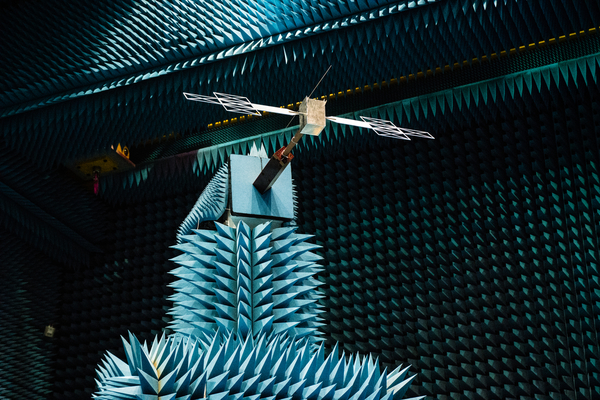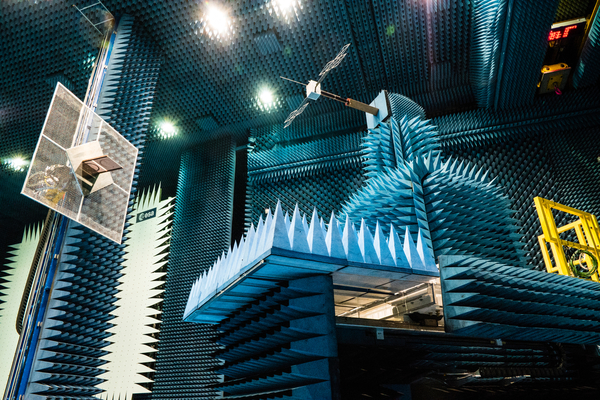#3: A testing time for RIME
12 November 2018
In September, ESA engineers put a scale model of JUICE's RIME antenna – Radar for Icy Moons Exploration – through its paces at ESA's technical centre in The Netherlands. |
| Minuaturised JUICE spacecraft and RIME antenna during electromagnetic compatibility tests at ESA's technical centre in the Netherlands. Credit: ESA–M. Cowan |
RIME is an ice-penetrating radar, operating at a frequency of 9 MHz, that will be used to remotely probe the subsurface structure of the large moons of Jupiter. Emitted by a 16-m long dipole antenna, the radar signals will penetrate the icy surfaces of the moons down to a depth of 9 km, providing a vertical resolution between 50 and 140 m.
Once in space, the instrument's performance will be influenced by several factors, including the radiation pattern of the antenna. Affecting this pattern will be the large size of the spacecraft itself, the solar array orientation, and the 10.6-m long magnetometer boom where the JMAG and some of the RPWI sensors instruments are hosted.
The initial assessment of the RIME antenna's performance is made through modelling and simulations, but ultimately the model needs to be validated through testing. Full radiation pattern testing would require involvement of the entire spacecraft and its solar array, as well as the 16-m long antenna. However, this is not feasible inside the Electro-Magnetic Compatibility test facility at the European Space Research and Technology Centre (ESTEC) in Noordwijk, The Netherlands, so a 1:18 scale model of the RIME antenna and a simplified model of the JUICE spacecraft were used during the recent tests.
 |
| Scale model of the JUICE spacecraft and RIME antenna during tests at ESA. Credit: ESA–M. Cowan |
Testing of a scaled-down model not only meant that the whole spacecraft structure was significantly smaller and the RIME antenna was shrunk to about 80 cm in length, but it also enabled the frequency of operation to be increased to 162 MHz – a much more suitable frequency to test in indoor anechoic chambers.
The antenna test took place at ESTEC's HERTZ facility, which combines two types of test range – the Compensated Compact Range (CCR) and a Near Field Range (NFR) – in the same anechoic room.
The so-called spherical near field range was used for the test, together with a probe that emits the signal to be received by the RIME antenna; the emitting unit was developed at ESTEC for this purpose. Several tests were performed, for different solar array orientations, with the objective of collecting a set of data that can be compared with the results obtained through the simulations and thus validate the design and verification approach.
 |
| Testing the RIME antenna for the JUICE mission. The signal received by the antenna during tests was emitting by a probe mounted on the square mesh on the left. Credit: ESA–M. Cowan |
The antenna measurements were performed by rotating the scaled model and the RIME antenna along two axes, in order to measure the electric near field on a spherical surface in the vicinity of the scaled model. The near field data were then processed to obtain the far field performance, which is of particular interest because it more closely resembles real antenna performance.
This test campaign was a proof of concept that enabled fine-tuning of all relevant parameters. At a later stage, the antenna's performance will be simulated with a high-fidelity model of the spacecraft, which will include all possible features that can influence the antenna pattern. These results will serve as inputs for the RIME instrument team to derive the overall inflight performance of the instrument.
About JUICE
JUICE – JUpiter ICy moons Explorer – is the first large-class mission in ESA's Cosmic Vision 2015-2025 programme. It will complete a unique tour of the Jupiter system that will include in-depth studies of three potentially ocean-bearing satellites, Ganymede, Europa and Callisto.
The Jupiter tour includes several flybys of each planet-sized world, and it ends with orbit insertion around Ganymede, the largest moon in the Solar System.
JUICE will carry the most powerful scientific payload ever flown to the outer Solar System. It consists of 10 state-of-the-art instruments plus one experiment that uses the spacecraft telecommunication system with ground-based instruments.
JUICE's instruments will enable scientists to compare each of these icy satellites and to investigate the potential for such bodies to harbour habitable environments such as subsurface oceans. They will also carry out observations of Jupiter, its atmosphere, magnetosphere, satellites and rings.
About the RIME antenna
The principal investigator institute of RIME – Radar for Icy Moons Exploration is Università degli Studi di Trento, Italy.







